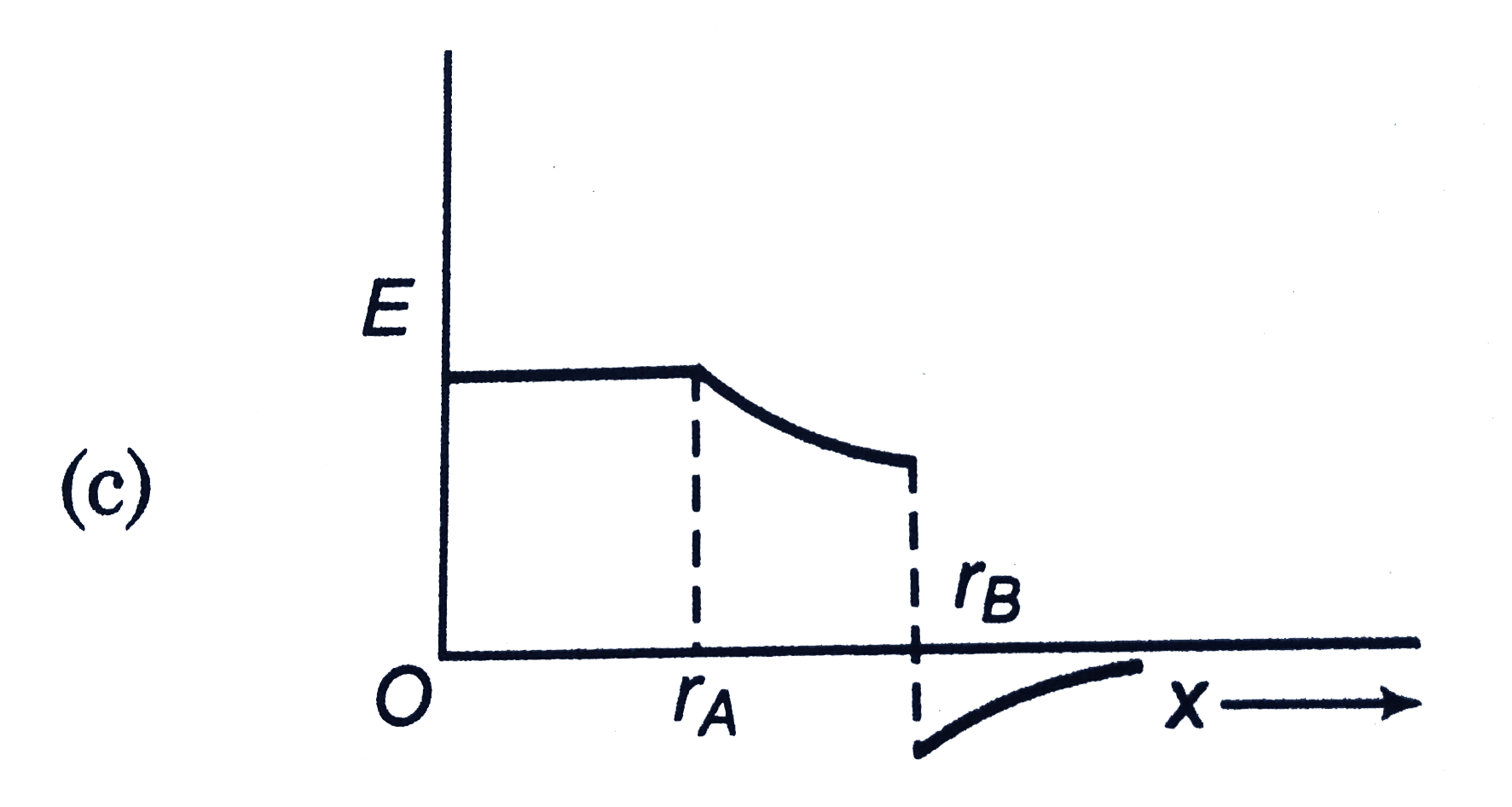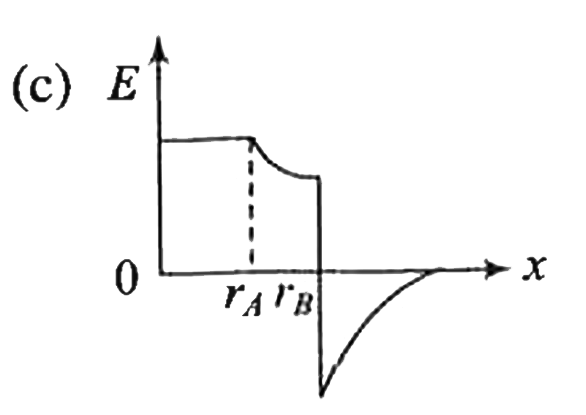Two concentric coducting thin spherical shells A and B having radii and are charged to and . The electrical field along a line passing through the centre is



none of these
The correct Answer is:A
To solve the problem of finding the electric field along a line passing through the center of two concentric conducting spherical shells A and B, we can follow these steps:
1. Understanding the Configuration:
- We have two concentric conducting spherical shells: Shell A with radius rA and charge QA, and Shell B with radius rB (where rB>rA) and charge −QB (where |QB|>|QA|).
- The electric field inside a conductor in electrostatic equilibrium is zero.
2. Electric Field Inside Shell A (0 to rA):
- For any point inside Shell A (i.e., at a distance r<rA), the electric field E=0 because the electric field inside a conducting shell is always zero.
3. Electric Field Between Shells (from rA to rB):
- In the region between the two shells (i.e., rA<r<rB), we can use Gauss's Law. The electric field is due to the charge on Shell A.
- The effective charge enclosed by a Gaussian surface in this region is QA.
- According to Gauss's Law:
E⋅4πr2=QAε0
- Therefore, the electric field E at a distance r from the center is given by:
E=QA4πε0r2
- This electric field is directed outward because QA is positive.
4. Electric Field Outside Shell B (from r>rB):
- For points outside Shell B (i.e., r>rB), we consider the net charge enclosed by a Gaussian surface that encompasses both shells.
- The total charge enclosed is QA−QB.
- Again applying Gauss's Law:
E⋅4πr2=QA−QBε0
- Thus, the electric field E for r>rB is:
E=QA−QB4πε0r2
- Since |QB|>|QA|, QA−QB<0, indicating that the electric field is directed inward.
5. Summary of Electric Field Behavior:
- E=0 for 0<r<rA
- E=QA4πε0r2 for rA<r<rB (outward)
- E=QA−QB4πε0r2 for r>rB (inward)
- We have two concentric conducting spherical shells: Shell A with radius rA and charge QA, and Shell B with radius rB (where rB>rA) and charge −QB (where |QB|>|QA|).
- The electric field inside a conductor in electrostatic equilibrium is zero.
- For any point inside Shell A (i.e., at a distance r<rA), the electric field E=0 because the electric field inside a conducting shell is always zero.
- In the region between the two shells (i.e., rA<r<rB), we can use Gauss's Law. The electric field is due to the charge on Shell A.
- The effective charge enclosed by a Gaussian surface in this region is QA.
- According to Gauss's Law:
E⋅4πr2=QAε0
- Therefore, the electric field E at a distance r from the center is given by:
E=QA4πε0r2
- This electric field is directed outward because QA is positive.
- For points outside Shell B (i.e., r>rB), we consider the net charge enclosed by a Gaussian surface that encompasses both shells.
- The total charge enclosed is QA−QB.
- Again applying Gauss's Law:
E⋅4πr2=QA−QBε0
- Thus, the electric field E for r>rB is:
E=QA−QB4πε0r2
- Since |QB|>|QA|, QA−QB<0, indicating that the electric field is directed inward.
- E=0 for 0<r<rA
- E=QA4πε0r2 for rA<r<rB (outward)
- E=QA−QB4πε0r2 for r>rB (inward)
Topper's Solved these Questions
- ELECTROSTATICSBOOK - DC PANDEYCHAPTER - ELECTROSTATICSEXERCISE - Exercise 24.1
4 Videos
- ELECTROSTATICSBOOK - DC PANDEYCHAPTER - ELECTROSTATICSEXERCISE - Exercise 24.2
9 Videos
- ELECTROSTATICSBOOK - DC PANDEYCHAPTER - ELECTROSTATICSEXERCISE - Example Type 8
3 Videos
- ELECTROSTATIC POTENTIAL AND CAPACITORSBOOK - DC PANDEYCHAPTER - ELECTROSTATIC POTENTIAL AND CAPACITORSEXERCISE - (C) Chapter exercises
50 Videos
- GRAVITATIONBOOK - DC PANDEYCHAPTER - GRAVITATIONEXERCISE - All Questions
120 Videos
Similar Questions
Two concentric conducting thin spherical shells A andB having radii rA and r8(r8>rA) are charged to QA and −QB(|QB|>|QA|). The electric field strength along a line passing through the centre varies with the distance x as :
View SolutionThere are two concentric conducting spherical shells of radius rA and rB respectively (rB=2rA). If the inner shell is given a charge Q and outer shell is given a charge 2Q, then the potential difference between the surfaces of the shells will be K=14πε0
View Solution
Knowledge Check
Two concentric conducting thin spherical shells A andB having radii rA and r8(r8>rA) are charged to QA and −QB(|QB|>|QA|). The electric field strength along a line passing through the centre varies with the distance x as :
A B
B C
C D
D
two concentric conducting thin spherical shells A and B having radii rAandrB(rB>rA are charged to QA and QA and (−QB/QBl>/QA/) . The electrical field along a line (passing through the centre) is
 A
A B
B C
C D
D
Two concentric thin conducting sphereical shells having radii R and 2R are as shown in the figure .A charge +Q is given to the shell A and −4Q is given to the shell B .If A and B are connected by a thin conducting wire then the amount of heat produced after the connection is
 A3Q24πε0RBQ216πε0RC5q28πε0RDQ28πε0R
A3Q24πε0RBQ216πε0RC5q28πε0RDQ28πε0R
Three concentric conducting spherical shells of radii R,2R and 3R carry charges Q,−2Q and 3Q, respectively.

a. Find the electric potential at r=R and r=3R where r is the radial distance from the centre. ltbr> b. Compute the electric field at r=52R
c.computethe→tale≤ctrostatice≠rgys→red∈thesystem.<br>The∈≠rshellisnowco∩ected→theexternalo≠byaconduct∈gwire,passingthroughaverysmallho≤∈them≤shell.<br>Computethechar≥sonthespheresofradiiRand3R.<br>e.Computethee≤ctricfieldatr=5/2R.
View SolutionFigure shows three concentric thin conducting spherical shells A, B and C of radii R, 2R and 3R. The shell B is earthed A and C are given charges q and 2q respectively. Find the charges appearing on all the surface of A,B and C.

[inner surface (A)0,(B)−q,(C)43q
Outer surface (A)q,(B)−43q,(C)23q]
View SolutionTwo concentric conducting shells A and B are of radii R and 2R. A charge +q is placed at the centre of the shells. Shell B is earthed and a charge q is given to shell A. Find the charge on outer surface of A and B.
View SolutionTwo thin cocentric and coplanar spherical shells , of radii 'a' and 'b' (b>a), carry charges q and Q respectively. Find the magnitude of the electric at a point distant x from their common centre for
0<x<a,
(b) a≤x≤b,
(c) b≤x<∞
View SolutionThree concentric conducting spherical shells have radii r, 2r, and 3r and charges q1,q2andq3, respectively. Innermost and outermost shells are earthed as shown in figure. The charges shown are after earthing. Select the correct alternative.

View Solution
